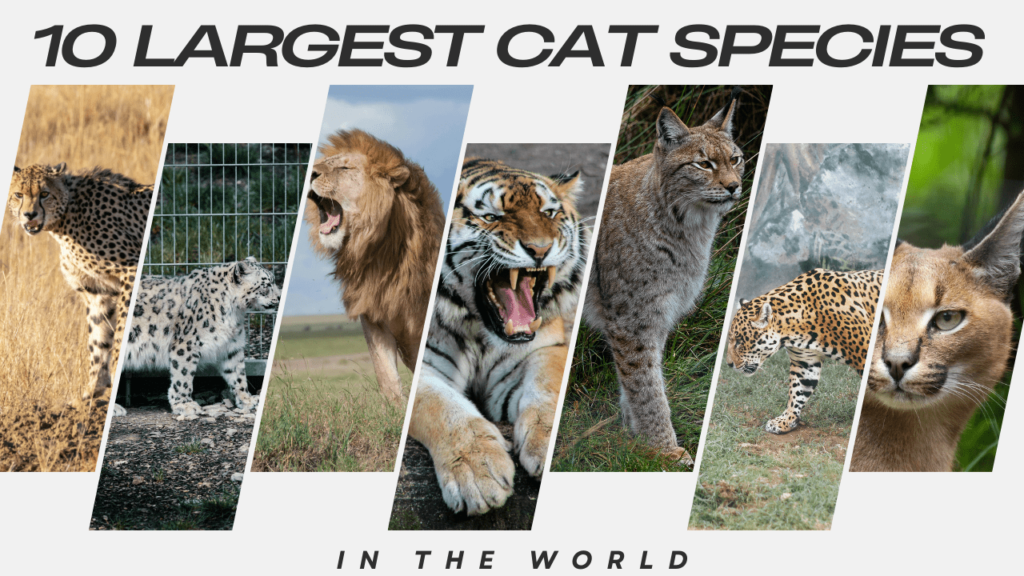Introduction
In the animal kingdom, the length of an animal’s neck can vary significantly, and this feature often plays a crucial role in their survival and behavior. Animals with long necks, such as giraffes and okapis, have evolved this characteristic to gain advantages that are vital for their existence. A long neck allows these creatures to reach high foliage, access food sources that other animals cannot, and improve their visibility in their habitat. This elevated perspective aids in spotting predators and locating potential mates from a distance.
However, having a long neck is not without its drawbacks. The extended neck can make these animals more vulnerable to injury and may require significant energy to support. Additionally, maintaining body temperature can be challenging due to the increased surface area, and the physical strain of the neck can place a burden on the spine and muscles. Despite these challenges, the evolutionary benefits of having a long neck have proven to be advantageous for many species.
Benefits of Having Long Necks
Enhanced Feeding: One of the primary benefits of having a long neck is the ability to reach high branches and foliage that are out of reach for other herbivores. This adaptation allows long neck animals like giraffes to access a food source that is abundant and less contested, giving them a competitive edge in their environment. By extending their reach, these animals can graze on leaves and fruits from tall trees that other herbivores cannot access, which is crucial for their survival.
Improved Visibility: Long neck animals provide a significant advantage in terms of visibility. Animals with extended necks can see over tall grasses or other obstacles in their environment, which helps them spot potential predators or locate mates from a greater distance. This heightened vantage point is essential for avoiding threats and finding resources in expansive habitats like savannas and forests.
Social Interaction: In addition to feeding and visibility, long necked animals play a role in social interactions among certain species. For example, male giraffes use their necks in combat, known as “necking,” to establish dominance and secure mating rights. This behavior is an important aspect of their social structure and reproduction, showcasing how animals with long necks contribute to social and reproductive strategies.
Drawbacks of Having Long Necks
Vulnerability: Despite the benefits, long neck animals also present several drawbacks. The extended length makes animals more vulnerable to injury, particularly during activities such as drinking water or moving through dense vegetation. For instance, giraffes must spread their legs and bend awkwardly to drink, which exposes them to potential predation.
Heat Regulation: The increased surface area of a long neck can pose challenges for maintaining body temperature. In hot environments, animals with long necks may struggle to regulate their heat efficiently, as the neck’s extended length can trap heat and make cooling more difficult. This thermal challenge requires adaptations to manage body temperature effectively.
Physical Strain: The weight and length of a long neck place a considerable strain on the animal’s spine and muscles. Supporting such a lengthy structure requires significant muscular effort and energy. Over time, this strain can lead to physical discomfort or even injuries, impacting the animal’s overall health and mobility.
Top 10 Animals with Long Necks:
10. Anhinga
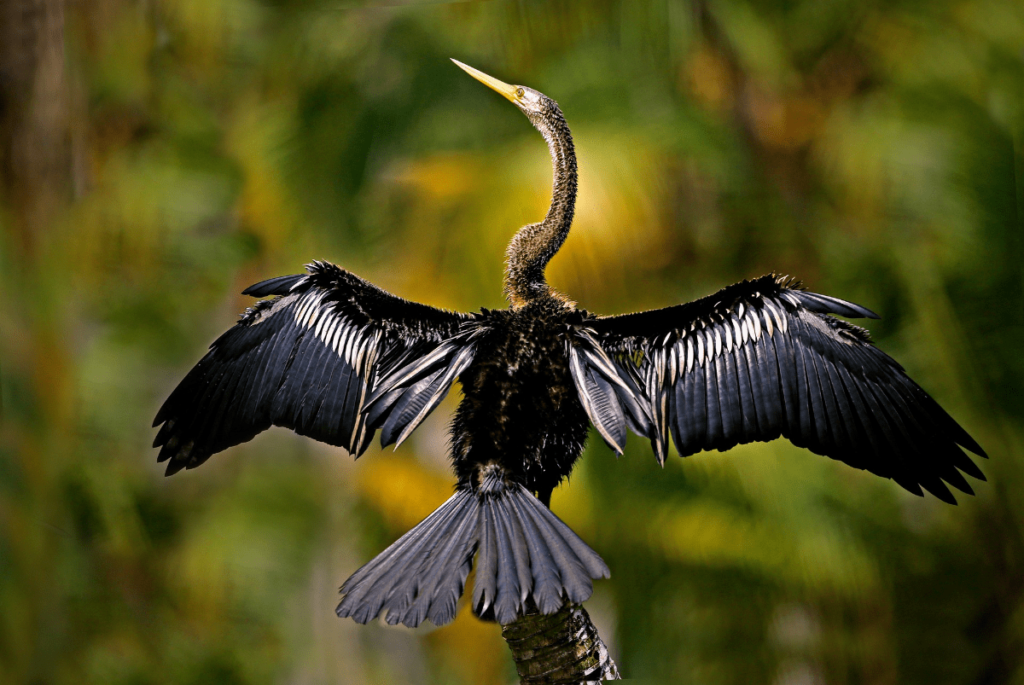
The Anhinga, often referred to as the “snakebird” due to its long neck and swimming posture, is a fascinating bird that exemplifies the unique adaptations of animals with long necks relative to their body size. Found in freshwater environments, this bird uses its neck to its full advantage while hunting and navigating its aquatic habitat.
- Neck Length: Approximately 0.6 meters (2 feet)
- Body Length: 0.8 to 1 meter (2.6 to 3.3 feet)
- Body Height: Up to 0.5 meters (1.6 feet) when fully extended
- Habitat: Freshwater lakes, rivers, and swamps across the Americas
- Diet: Fish, amphibians, and small aquatic creatures
Benefits: The Anhinga’s long neck is highly adapted for catching prey in the water. Its ability to extend its neck allows it to reach fish and other aquatic animals with precision while keeping most of its body submerged. This adaptation enhances its hunting efficiency and makes it a formidable predator in its habitat.
Drawbacks: Despite its advantages, the Anhinga’s long neck can make it vulnerable to certain predators and environmental conditions. Its neck requires significant muscular effort to maneuver and can be a liability if the bird needs to make quick movements or escape rapidly. Additionally, the Anhinga’s neck is prone to injury due to its length and the need for precise movements.
9. Flamingo

Flamingos are one of the most iconic long-necked animals in the bird world. Their bright pink plumage and graceful movements make them easily recognizable, and their neck-to-body ratio helps them thrive in their unique habitats.
- Scientific Name: Phoenicopterus roseus
- Neck Length: Up to 1 meter (3.3 feet)
- Body Length: 1.2 to 1.5 meters (4 to 5 feet)
- Body Height: 1.2 to 1.5 meters (4 to 5 feet)
- Habitat: Shallow lakes, lagoons, and wetlands
- Diet: Algae, small crustaceans, and plankton
Benefits: The flamingo’s long neck allows it to reach deep into the water while standing upright, helping it filter-feed for small organisms like algae and shrimp. This feeding method is critical for their diet and is a major reason behind their iconic pink color, which comes from the carotenoid pigments in their food. Additionally, their neck helps them balance while navigating shallow waters, giving them more reach while staying upright.
Drawbacks: The long neck of the flamingo, while useful, can be a disadvantage when flying. They need to extend it fully, which can make flight less streamlined compared to other birds. Flamingos are also vulnerable when bending down to drink water, as their neck exposes them to potential predators. Their distinctive neck position also limits their habitat to shallow waters, meaning they can’t forage for food in deeper areas.
8. Heron

Herons, with their sleek and elegant figures, are another remarkable example of animals with long necks. They are often seen standing still in shallow water, waiting for the perfect moment to strike at prey with their long beaks and necks.
- Scientific Name: Ardea herodias
- Neck Length: Up to 1 meter (3.3 feet)
- Body Length: 91 to 137 cm (3 to 4.5 feet)
- Body Height: 1 to 1.4 meters (3.3 to 4.6 feet)
- Habitat: Wetlands, marshes, lakes, and rivers
- Diet: Fish, amphibians, small mammals, and insects
Benefits: The heron’s long neck gives it a distinct advantage when hunting. It acts like a spear, allowing the heron to quickly strike at fish or other prey in the water. This flexibility helps herons remain still for long periods, camouflaging them from their prey. Their neck also enhances their field of vision, allowing them to spot threats from a distance.
Drawbacks: The heron’s long neck can become a burden in strong winds or harsh weather, making balance difficult. In addition, the long neck may expose herons to injuries or make them more noticeable to predators. Their reliance on wetland habitats, where they can use their necks to fish, means habitat destruction poses a serious threat to their survival.
7. Okapi
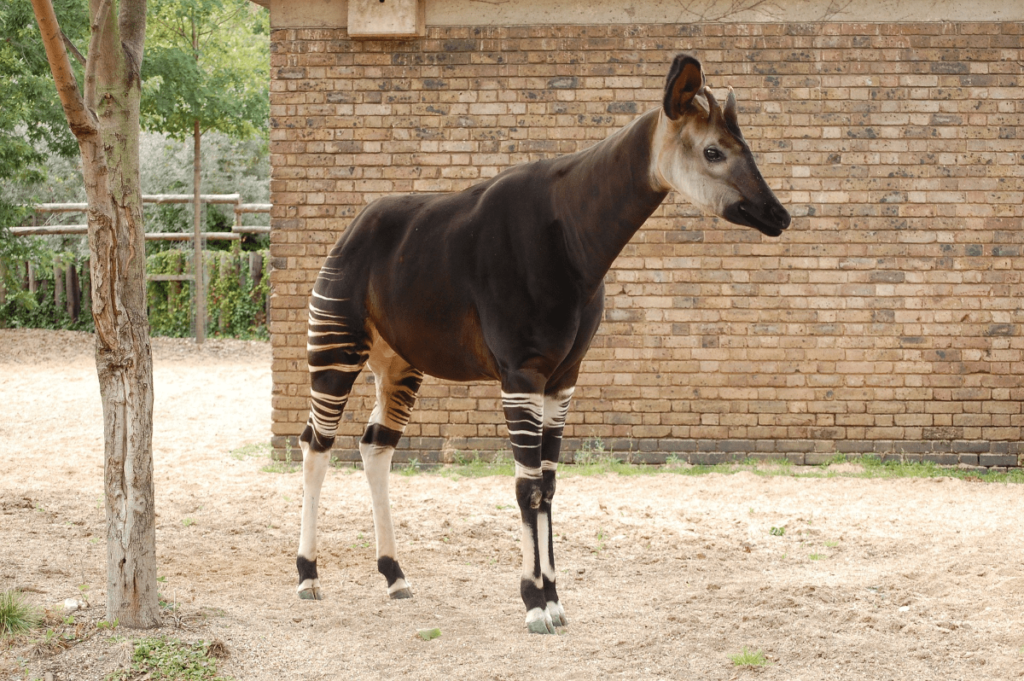
The okapi, often referred to as the “forest giraffe,” is a relative of the giraffe with a much shorter neck, but it still qualifies as an animal with a long neck in proportion to its body. This elusive animal lives in dense rainforests, and its striking resemblance to both zebras and giraffes makes it a unique species.
- Scientific Name: Okapia johnstoni
- Neck Length: 40 to 50 cm (16 to 20 inches)
- Body Length: 2 to 2.5 meters (6.5 to 8.2 feet)
- Body Height: 1.5 to 2 meters (5 to 6.5 feet) at the shoulder
- Habitat: Dense rainforests of the Congo Basin
- Diet: Leaves, buds, and fruits
Benefits: Although the okapi’s neck is shorter than that of its relative, the giraffe, its long neck helps it reach vegetation in dense forests. Its flexibility allows it to navigate through thick underbrush and feed on plants that are out of reach for other animals. The okapi’s unique neck also aids in communicating with others of its species, as they use low-frequency sounds that travel through the dense foliage.
Drawbacks: The long neck of the okapi, while useful, makes it harder for the animal to move quickly through dense forest terrain. This can make it more vulnerable to predators like leopards. Additionally, due to their relatively smaller size compared to giraffes, they don’t have the same elevated field of vision, limiting their ability to spot predators in time.
6. Camel

Camels are well-known for their ability to thrive in harsh desert environments, and they are also recognized as long necked animals. Their long necks help them reach vegetation that grows sparsely in desert landscapes, making them well-adapted to their environment.
- Scientific Name: Camelus dromedarius (Dromedary) / Camelus bactrianus (Bactrian)
- Neck Length: 50 to 70 cm (1.6 to 2.3 feet)
- Body Length: 2.2 to 3.5 meters (7.2 to 11.5 feet)
- Body Height: 1.8 to 2.1 meters (6 to 7 feet) at the shoulder
- Habitat: Deserts and arid regions of the Middle East, North Africa, and Central Asia
- Diet: Thorny plants, dry grasses, and shrubs
Benefits: The camel’s long neck allows it to reach sparse, high vegetation in arid environments, such as thorny bushes and trees, which other animals may not be able to access. This gives camels a feeding advantage in deserts where food is scarce. Their long necks also help with thermoregulation by keeping their heads elevated, reducing the amount of body heat absorbed from the desert floor. Additionally, camels can spot distant predators or other camels from a greater distance, aiding in survival and social interactions.
Drawbacks: While camels’ long necks provide clear advantages, they also have some drawbacks. The length and weight of the neck can cause strain when the camel needs to bend down to drink water, making them vulnerable to predators during this time. Additionally, in environments with low-hanging vegetation, the camel’s height can be a disadvantage, limiting access to food near the ground.
Also, Check out How Do Camels Survive in the Desert
5. Swan
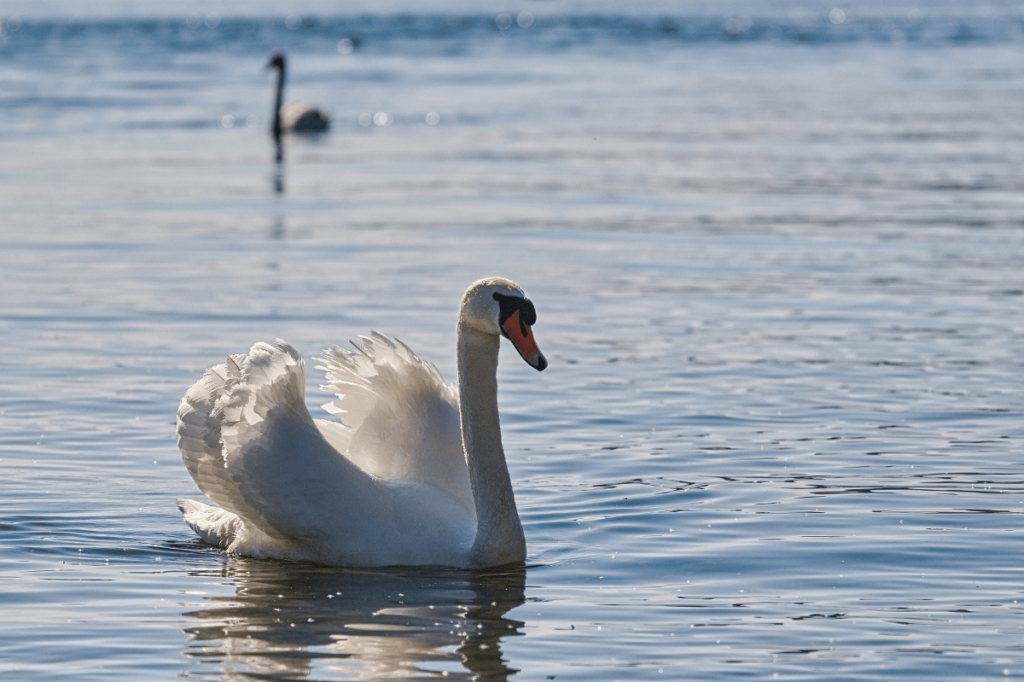
Swans are graceful long necked animals, known for their elegant appearance and their impressive neck length, which plays a crucial role in their aquatic lifestyle. Their long necks are one of their defining features, allowing them to thrive in lakes, ponds, and rivers.
Swans don’t just have long necks, but also maintain long relationships. Swans comes at #1 in our list of Top 10 Animals That Mate for Life. Discover which other animals made the list.
- Scientific Name: Cygnus species (e.g., Mute Swan: Cygnus olor)
- Neck Length: Up to 1 meter (3.3 feet)
- Body Length: 1.2 to 1.7 meters (4 to 5.5 feet)
- Body Height: Up to 1.2 meters (4 feet)
- Habitat: Freshwater lakes, ponds, rivers, and wetlands
- Diet: Aquatic plants, small fish, insects, and algae
Benefits: Swans’ long necks are highly advantageous in aquatic environments. They allow swans to reach underwater vegetation without needing to dive completely, which conserves energy. Their long necks also help with preening their feathers, keeping them clean and waterproof, which is essential for maintaining their buoyancy and insulation in cold water. Additionally, swans use their necks during courtship displays, where graceful movements play a role in attracting mates.
Drawbacks: The swan’s long neck can also be a liability. When feeding underwater or preening, swans may not be as alert to predators, leaving them vulnerable to attacks, especially from land-based animals like foxes. Furthermore, the long neck requires extra energy to support and maintain, which can lead to physical strain over time, particularly in older swans.
4. Llama

When thinking of animals with long necks, the llama might not come to mind immediately, but these gentle creatures possess a notable neck-to-body ratio that aids in their mountainous habitat.
- Scientific Name: Lama glama
- Neck Length: Approximately 40 to 60 cm (1.3 to 2 feet)
- Body Length: 1.6 to 1.8 meters (5.2 to 6 feet)
- Body Height: Up to 1.8 meters (6 feet) at the shoulder
- Habitat: Mountainous regions of South America, particularly the Andes
- Diet: Grasses, shrubs, and low-lying vegetation
Benefits: The llama’s long neck allows it to efficiently graze on a wide variety of vegetation, from grasses to shrubs, in its native Andean habitat. Its neck also gives llamas enhanced visibility in mountainous regions, helping them keep an eye out for predators while foraging. In social interactions, llamas may use their necks to posture and communicate dominance or submission within the herd.
Drawbacks: However, the llama’s long neck can also present drawbacks. In their native environment, the additional height may make llamas more exposed to predators, especially when they are feeding. Moreover, supporting the long neck in steep and rugged terrain can sometimes place strain on their musculoskeletal system, potentially leading to injury over time.
3. Alpaca

Alpacas, though smaller than llamas, share many similar characteristics, including their distinctively long necks. These long neck animals are highly valued for their wool and are well-adapted to life in high-altitude environments. With neck size upto 1.6 feet, Alpacas can be called the animal with long neck.
- Scientific Name: Vicugna pacos
- Neck Length: Approximately 30 to 50 cm (1 to 1.6 feet)
- Body Length: 1.2 to 1.5 meters (4 to 5 feet)
- Body Height: Up to 1.5 meters (5 feet)
- Habitat: Andes mountains in South America
- Diet: Grasses, leaves, and shrubs
Benefits: Like llamas, alpacas’ long necks provide several advantages. The length enables alpacas to reach a variety of plant life, from grasses to shrubs, which helps them thrive in their Andean habitat. The neck also aids them in observing their surroundings, offering better protection against potential predators. Alpacas often use their necks for communication within their herds, displaying various behaviors that signal social rank or mood.
Drawbacks: Despite the advantages, alpacas’ long necks can be a burden. In colder climates, maintaining body temperature can be more challenging with a longer neck, as more heat is lost from this extended surface area. The additional strain of supporting their neck can also lead to musculoskeletal problems, especially as alpacas age or in harsher terrain.
2. Ostrich

The ostrich, the world’s largest bird, is well-known for its long legs and neck, making it one of the most prominent long neck animals in the avian world. Despite being flightless, the ostrich’s neck is a key feature in its ability to navigate its environment.
Ostrich is also one of the Fastest Animals in the world.
- Scientific Name: Struthio camelus
- Neck Length: Approximately 1 meter (3.3 feet)
- Body Length: 2 to 2.7 meters (6.6 to 9 feet)
- Body Height: Up to 2.8 meters (9 feet)
- Habitat: African savannas and deserts
- Diet: Seeds, shrubs, grasses, and insects
Benefits: The ostrich’s long neck plays a crucial role in its survival. It allows the ostrich to spot predators from a great distance, giving it time to escape. Additionally, it helps them access food sources on the ground while their legs allow them to cover large distances. The neck’s flexibility also aids in foraging, allowing ostriches to navigate through various landscapes to find food efficiently.
Drawbacks: Despite these benefits, the ostrich’s long neck can also be a disadvantage. Its height and visibility make it an easier target for predators, especially when it is foraging. Moreover, because of the neck’s length, ostriches need to spend additional energy in supporting and maintaining balance, which can lead to fatigue in certain conditions. This height can also make it challenging for them to hide from predators.
1. Giraffe

Giraffes might be the first animal that comes to mind when we talk about animals with long necks. Their towering stature makes them the tallest mammals on Earth, and their unique adaptation provides them with several ecological advantages.
- Scientific Name: Giraffa camelopardalis
- Neck Length: Up to 6 meters (20 feet)
- Body Length: Approximately 4.3 to 4.9 meters (14 to 16 feet)
- Body Height: Up to 5.5 to 6 meters (18 to 20 feet) at the shoulder
- Habitat: African savannas and open woodlands
- Diet: Leaves and fruits from trees
Benefits: The giraffe’s long neck provides several advantages. It allows them to reach high branches and foliage that other herbivores cannot access, giving them a competitive edge in their environment. This height also enables them to spot predators from a distance, enhancing their survival chances. Additionally, giraffes use their necks in social interactions, such as “necking” fights between males to establish dominance and secure mating rights.
Drawbacks: Despite these advantages, having such a long neck presents challenges. Drinking water is a cumbersome process as giraffes must spread their legs and bend awkwardly, making them vulnerable to predators during this time. The weight and length of their neck also place strain on their cervical vertebrae, which can lead to physical discomfort or injuries. Furthermore, their height can make it difficult for them to move through dense vegetation.
The fear of Predators also made Giraffe sleep less than 6 hours a day. Check out How Long Do Giraffes Sleep
Comparison Table:
| S. No. | Common Name | Scientific Name | Neck Length | Body Length | Body Height | Habitat | Diet |
|---|---|---|---|---|---|---|---|
| 1 | Giraffe | Giraffa camelopardalis | Up to 6 meters (20 feet) | Approximately 4.3 to 4.9 meters (14 to 16 feet) | Up to 5.5 to 6 meters (18 to 20 feet) at the shoulder | African savannas and open woodlands | Leaves and fruits from trees |
| 2 | Ostrich | Struthio camelus | Approximately 1 meter (3.3 feet) | 2 to 2.7 meters (6.6 to 9 feet) | Up to 2.8 meters (9 feet) | African savannas and deserts | Seeds, shrubs, grasses, and insects |
| 3 | Alpaca | Vicugna pacos | Up to 0.5 meters (1.6 feet) | 0.8 to 1 meter (2.6 to 3.3 feet) | Up to 1 meter (3.3 feet) | Andean mountains of South America | Grasses, hay, and plants |
| 4 | Llama | Lama glama | Up to 0.6 meters (2 feet) | 1.8 to 2 meters (5.9 to 6.6 feet) | Up to 1.8 meters (6 feet) | Andean mountains of South America | Grasses, hay, and plants |
| 5 | Swan | Cygnus atratus | Approximately 1 meter (3.3 feet) | 1.4 to 1.8 meters (4.6 to 5.9 feet) | Up to 1.5 meters (5 feet) | Lakes, rivers, and marshes | Aquatic plants, small fish, and insects |
| 6 | Camel | Camelus dromedarius | Approximately 0.6 meters (2 feet) | 2.3 to 3.3 meters (7.5 to 10.8 feet) | Up to 2.5 meters (8.2 feet) | Deserts and arid regions | Grasses, leaves, and grains |
| 7 | Okapi | Okapia johnstoni | Up to 1.5 meters (5 feet) | Approximately 2.5 to 3 meters (8 to 10 feet) | Up to 1.8 meters (6 feet) | Rainforests of Central Africa | Leaves, fruits, and flowers |
| 8 | Heron | Ardea herodias | Approximately 0.9 meters (3 feet) | 0.9 to 1.3 meters (3 to 4.3 feet) | Up to 1.2 meters (4 feet) | Wetlands, rivers, and lakes | Fish, amphibians, and insects |
| 9 | Flamingo | Phoenicopterus roseus | Approximately 0.9 meters (3 feet) | 1.2 to 1.5 meters (4 to 5 feet) | Up to 1.4 meters (4.6 feet) | Shallow lakes and lagoons | Algae, small crustaceans, and insects |
| 10 | Anhinga | Anhinga anhinga | Approximately 0.6 meters (2 feet) | 0.8 to 1 meter (2.6 to 3.3 feet) | Up to 0.5 meters (1.6 feet) | Freshwater lakes, rivers, and swamps | Fish, amphibians, and small aquatic creatures |
Here are 5 Bonus Animals with Long Necks Relative to Their Body Size
These animals may not have the longest necks overall, but their neck-to-body ratios are impressively disproportionate! These adaptations provide them with unique advantages in their respective environments, though they also come with certain challenges.
1. Snake-necked Turtle (Chelodina longicollis)

The Snake-necked Turtle is also of the animals with long necks. This turtle species is famous for its extremely elongated neck, which can be as long as its body, allowing it to quickly strike at prey from a distance.
You might also be interested in understanding the Difference between Tortoise Vs Turtle Vs Terrapin
- Neck Length: Up to 25 cm (10 inches)
- Body Length: Approximately 25 to 30 cm (10 to 12 inches)
- Habitat: Freshwater rivers and wetlands in Australia
- Diet: Aquatic invertebrates and small fish
Benefits: The long neck allows the snake-necked turtle to ambush prey with precision, giving it an edge in hunting.
Drawbacks: Its long neck makes it more vulnerable to predators, especially when exposed outside its shell.
2. Black Mamba (Dendroaspis polylepis)
Known for its agility and speed, the black mamba’s long, slender neck allows it to raise a significant portion of its body off the ground when striking at threats or prey.
- Neck Length: Approximately 50 cm (20 inches)
- Body Length: 2 to 4.5 meters (6.6 to 14.8 feet)
- Habitat: Savannas, woodlands, and rocky hills in Africa
- Diet: Small mammals, birds, and other reptiles
Benefits: The ability to lift its neck high helps the black mamba strike effectively and survey its surroundings.
Drawbacks: While its neck provides power in attacks, it also makes the black mamba a more noticeable target in open environments.
3. Pleurodira Turtles (Side-necked Turtles)
These turtles are known for retracting their heads sideways into their shells, rather than straight back, giving them a unique neck structure. Hence, we included them in the list of long neck animals.
- Neck Length: Varies by species, generally around 15 to 20 cm (6 to 8 inches)
- Body Length: 20 to 50 cm (8 to 20 inches)
- Habitat: Freshwater rivers, lakes, and swamps in South America and Africa
- Diet: Aquatic plants, insects, and small fish
Benefits: The flexibility of their necks allows side-necked turtles to efficiently forage and avoid predators by retracting their heads sideways.
Drawbacks: Their unique neck retraction mechanism can limit their range of movement and make them less agile on land.
4. Gerenuk (Litocranius walleri)

This antelope, known for its giraffe-like neck, is well-adapted to browsing on leaves and shoots in its arid habitat.
- Neck Length: Approximately 40 cm (16 inches)
- Body Length: 1.2 to 1.6 meters (4 to 5.2 feet)
- Body Height: Up to 1.5 meters (5 feet)
- Habitat: Arid and semi-arid regions of East Africa
- Diet: Leaves, shoots, and fruits from shrubs and trees
Benefits: The gerenuk’s long neck enables it to browse on leaves and shoots that are out of reach for other herbivores, providing it with access to a unique food source.
Drawbacks: Its neck can make it less agile when moving through dense underbrush and may also increase its visibility to predators.
5. Sauropods – The Animal with the Longest Neck in History of the World.
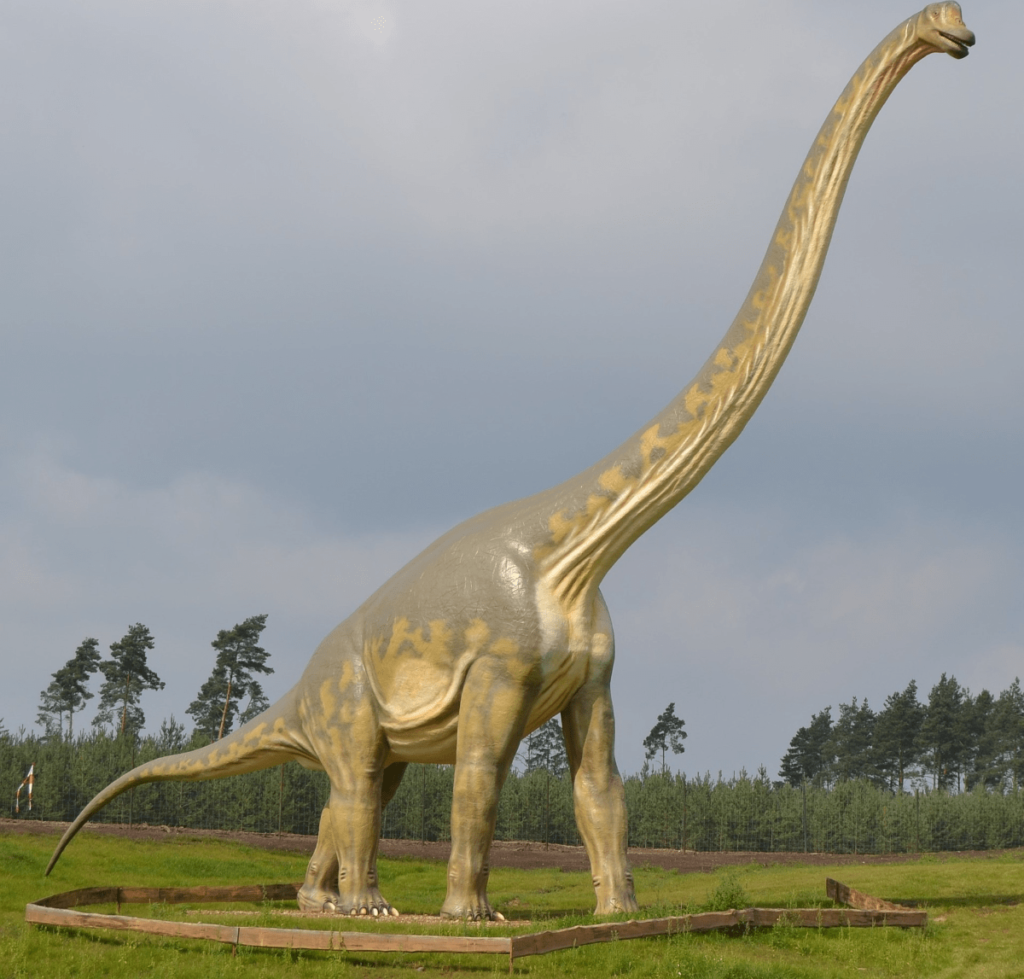
Sauropods is the largest and most famous longest neck animal that ever walked the Earth. These prehistoric giants, including species like Brachiosaurus and Apatosaurus, are well-known for their immense size and incredibly long necks, which could stretch up to several meters.
Sauropods, such as Brachiosaurus and Diplodocus, boast the longest necks of any known animals in history. These colossal dinosaurs had necks that could reach up to 15 meters (49 feet) in length, allowing them to graze on vegetation high up in trees and access otherwise unreachable food sources.
While their long necks provided significant feeding advantages, they also posed challenges, such as increased strain on their bodies and difficulties navigating through dense vegetation. Sauropods remain an impressive example of extreme neck length in the natural world.
- Scientific Name: Varies by species (e.g., Brachiosaurus, Apatosaurus)
- Neck Length: Up to 15 meters (50 feet) depending on species
- Body Length: 20 to 30 meters (65 to 100 feet) depending on species
- Body Height: Up to 12 meters (40 feet)
- Habitat: Forests and floodplains (prehistoric environments)
- Diet: Herbivorous, primarily feeding on trees and tall vegetation
Benefits: The long neck of sauropods allowed them to reach vegetation high up in trees, giving them access to food sources that smaller herbivores couldn’t reach. This adaptation helped them thrive in various environments, ensuring that they had less competition for resources. Their towering height also made it easier for sauropods to spot predators from afar, giving them more time to react and defend themselves.
Drawbacks: Having such a massive long neck came with physical challenges. Supporting such a large neck required a lot of energy and placed immense strain on their spine and muscles. Sauropods had to consume vast amounts of food to fuel their enormous bodies. Additionally, their size made it difficult to hide from predators, though their sheer bulk likely deterred many attackers.
Sauropods is literally the animal with long neck.
Conclusion
The fascinating adaptations of animals with long necks showcase the incredible diversity of nature’s solutions to survival challenges. From the towering giraffe to the agile snake-necked turtle, each species demonstrates how a long neck can enhance feeding, improve visibility, and offer unique evolutionary advantages. However, these adaptations come with their own set of drawbacks, including vulnerability to predators and physical strain.
Whether it’s the giraffe’s impressive reach or the anhinga’s specialized hunting technique, long necks play a crucial role in the lives of these remarkable creatures. Understanding these adaptations helps us appreciate the complexity of evolution and the intricate balance that these animals maintain in their environments.
We hope you enjoyed learning about these extraordinary animals and their long necks. If you found this article interesting, please share it with others who might appreciate it. Feel free to leave a comment below with your thoughts or any other long-necked animals you find fascinating. Your feedback and sharing help us bring more exciting content to you!


